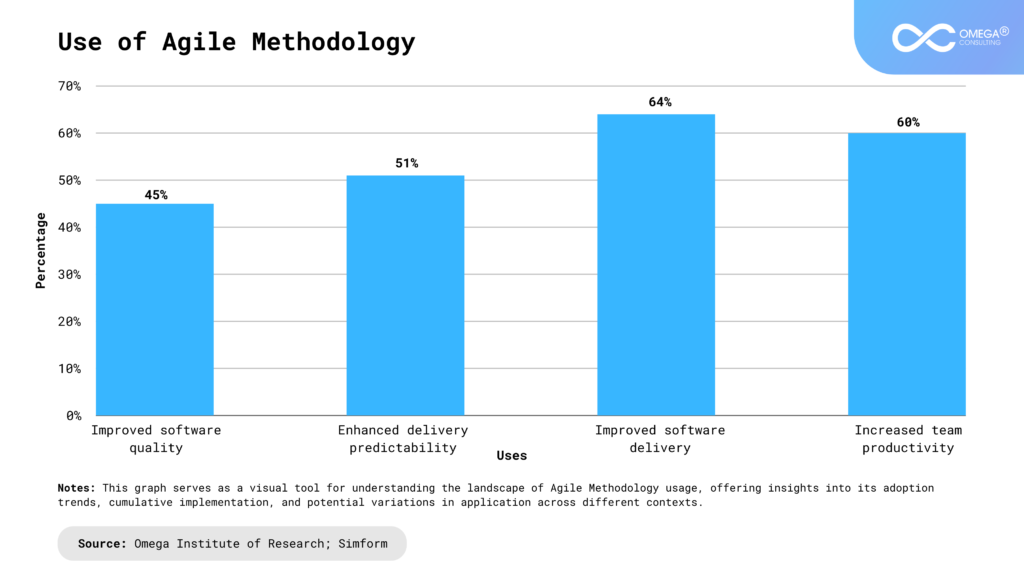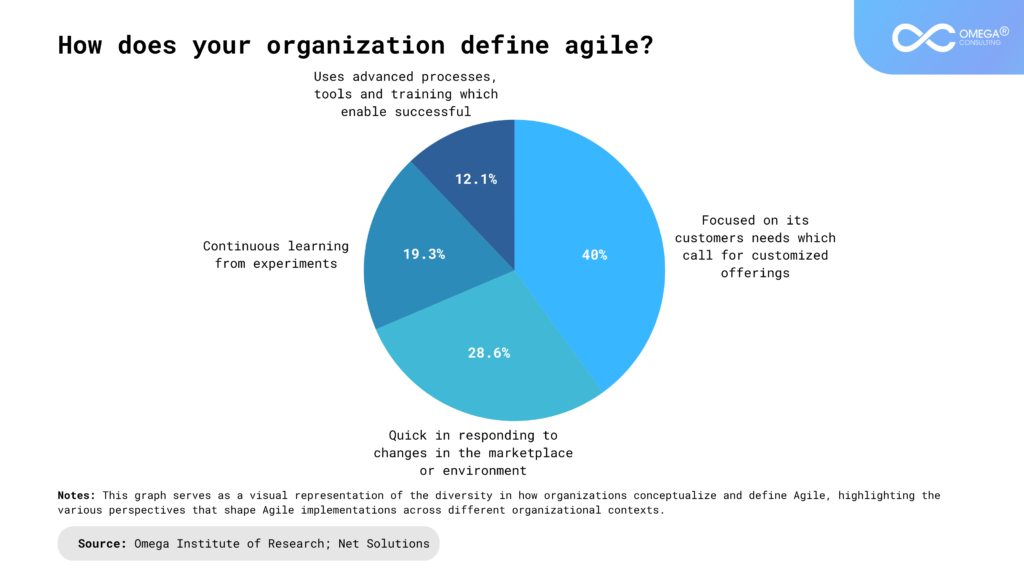- Industries
Industries
- Functions
Functions
- Insights
Insights
- Careers
Careers
- About Us
- Information Technology
- By Omega Team

In an era defined by rapid technological advancements and shifting market landscapes, Chief Information Officers (CIOs) and Chief Technology Officers (CTOs) find themselves at the forefront of steering organizations through the imperative of adaptation. The traditional project management methods that once sufficed now falter in the face of constant change, resulting in inefficiencies and missed opportunities. This is where Agile methodologies emerge as a dynamic framework, specifically designed to empower organizations and, crucially, align with the strategic visions of CIOs and CTOs in navigating the complexities of today’s business environments.
Understanding Agile Methodologies
Agile is not just a project management approach; it’s a philosophy that prioritizes flexibility, collaboration, and responsiveness. Originating in software development, Agile has transcended industry boundaries, offering a set of principles encapsulated in the Agile Manifesto. This manifesto places a premium on individuals and interactions, working solutions, and customer collaboration over rigid processes and exhaustive documentation.

Key Principles of Agile Methodologies
Customer Collaboration over Contract Negotiation
Agile’s emphasis on continuous collaboration ensures that the end product aligns closely with user needs. Consider a scenario where a software development company actively engages end-users throughout the design and development process, resulting in a product finely tuned to user expectations.
Responding to Change over Following a Plan
Embracing change as an integral part of the process, Agile teams remain adaptable, adjusting priorities and strategies in response to emerging challenges. Picture a marketing team adjusting its campaign strategy based on real-time market feedback to stay ahead of shifting consumer preferences.
Individuals and Interactions over Processes and Tools
The Agile methodology values human collaboration, recognizing that success hinges on the effectiveness of team interactions. Imagine cross-functional teams from different departments collaborating on a project, leveraging diverse skills and expertise to achieve superior results.
Working Solutions over Comprehensive Documentation
Agile prioritizes delivering functional solutions over exhaustive documentation, promoting an efficient and streamlined development process. Visualize a product development team creating a minimum viable product (MVP) to gather user feedback quickly and make improvements iteratively.

Agile Frameworks and Practices
Exploring Agile frameworks in-depth reveals unique characteristics and applications.
Scrum
Scrum, a popular framework, divides work into short, time-boxed iterations known as sprints. It promotes transparency, collaboration, and regular feedback through ceremonies like sprint planning and reviews. A software development team using Scrum releases iterative updates, ensuring each sprint results in a potentially shippable product increment.
Scrum Success Story
Consider XYZ Tech, which adopted Scrum to develop a new software product, successfully launching it ahead of schedule and gaining a competitive edge.
Kanban
Kanban optimizes workflow by visually representing the entire process. Visual boards provide real-time insights into tasks, bottlenecks, and completed work. A project management team using Kanban visualizes its workflow, identifying and resolving bottlenecks to optimize efficiency.
Kanban Implementation
Imagine ABC Manufacturing streamlining its supply chain processes using Kanban, resulting in cost savings and improved customer satisfaction.
Extreme Programming (XP)
XP places a strong emphasis on technical excellence and customer satisfaction. Practices like pair programming and continuous integration ensure a high-quality product. A software development team adopting XP practices improves code quality, delivering a more reliable and maintainable software product.
XP Success Story
Consider DEF Financial’s Agile Transformation using Extreme Programming, significantly reducing defects and increasing customer trust.
Benefits of Agile Methodologies for Adaptive Change
Increased Flexibility
Agile allows teams to respond quickly to changing requirements, ensuring projects stay aligned with business goals. An e-commerce company adapts its website features based on user feedback, providing a seamless online shopping experience.
Enhanced Collaboration
Agile fosters a collaborative environment where cross-functional teams work closely together. An Agile marketing team collaborates with product development, sales, and customer support teams for cohesive product launches.
Faster Time-to-Market
Iterative development results in faster time-to-market. A mobile app development team releases regular updates, keeping users engaged and attracting new customers.
Improved Customer Satisfaction
Agile involves customers throughout the development process, increasing the likelihood of delivering products that exceed expectations. A software company incorporates user feedback into each development sprint, anticipating future requirements.
Continuous Improvement
Agile encourages a culture of continuous improvement through regular retrospectives. A project management team conducts retrospectives, identifying and addressing bottlenecks for increased project efficiency.

Challenges and Considerations
Resistance to Change
Overcoming resistance to Agile adoption involves comprehensive training and gradual introduction to build familiarity and confidence among team members.
Need for Skilled Agile Practitioners
Successful Agile implementation requires skilled practitioners. Investing in training programs and hiring experienced Agile coaches ensures proficiency.
Effective Communication
Agile’s success hinges on communication. Promoting a culture of open communication and leveraging collaboration tools facilitates effective information exchange.
Tailoring Agile Practices
While Agile principles are universal, practices may need to be tailored. Encouraging teams to adopt Agile practices fosters a sense of ownership and empowerment.
Conclusion
In a world defined by perpetual change, Agile methodologies provide a framework for organizations to thrive. By prioritizing flexibility, collaboration, and responsiveness, Agile enables teams to deliver value rapidly, adapt to evolving requirements, and foster continuous improvement. Embracing Agile is not just a project management choice; it’s a strategic decision to remain competitive and resilient amid uncertainty.
This extended exploration of Agile methodologies delves into frameworks, practices, and case studies, offering a comprehensive understanding of how organizations can leverage Agile principles for adaptive change. As the business landscape evolves, Agile methodologies remain an indispensable tool for organizations navigating the challenges of today and the uncertainties of tomorrow.
- https://www.wrike.com/project-management-guide/faq/what-is-agile-methodology-in-project-management/
- https://www.researchgate.net/publication/31957499_A_framework_for_adapting_agile_development_methodologies
- https://www.ncbi.nlm.nih.gov/pmc/articles/PMC9362493/
- https://processmix.com/agile-process-management-adapting-to-change-with-speed-and-flexibility/
- https://zenkit.com/en/blog/agile-methodology-an-overview/
Subscribe
Select topics and stay current with our latest insights
- Functions